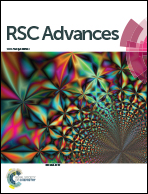Size and distribution control of surface plasmon enhanced photoluminescence and SERS signal in Ag–GaN hybrid systems†
Abstract
In the present experiment, two GaN nanowall network (NWN) samples with different porosity were grown on c-sapphire substrates using plasma assisted molecular beam epitaxy (PA-MBE). Ag nanoparticles were deposited on both the samples using a physical vapour deposition (PVD) system. Annealing the samples at different temperatures resulted in a change in Ag nanoparticle size due to diffusion and Ostwald ripening which had significant effect on the photoluminescence and SERS activity of GaN NWN. It was observed that the photoluminescence yield increased by more than five times in both cases at 200 °C. The SERS activity for thiophenol is higher in the as-deposited case for the sample with higher porosity, but after annealing to 200 °C the activity increased for the sample with lower porosity. It is also interesting to observe that the sample with higher porosity shows SERS signals even after being annealed to higher temperatures. Studies are also done for other analytes such as R6G and BSA. The results are discussed in terms of plasmonic effects of Ag nanoparticles on the excitonic emission from the GaN surface, which is also simulated using 2D-FDTD simulations.


 Please wait while we load your content...
Please wait while we load your content...